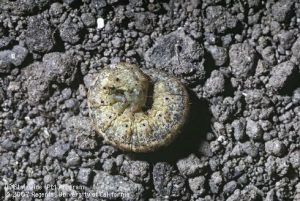How often have you transplanted young seedlings only to find your vegetables or flowering annuals lying on the ground in the morning? The succulent stems of the plants have been completely severed at the soil level, leaving the roots in the ground and the top scorching in the morning sun.
The culprit is the notorious cutworm. If you dig into the ground a few inches next to the cut stems you may see a greasy-looking, fat, worm-like caterpillar curled into a C-shape, gray to brown in color and about two inches in length. One good swat with your trowel will eliminate this guy forever, but it’s too late for your poor, dead seedlings.
These cutworms are not worms at all, but are the caterpillar larvae of various species of night flying moths such as the Greasy or Black Cutworm or the Variegated Cutworm. The adult moths lay eggs in garden debris and soil. Once hatched, the cutworm larvae feed on vegetation at night such as vegetables, flowering plants and any type of grass. They chew on stems of plants and blades of grass at ground level and may even chew irregular holes in crops such as tomatoes that are lying on the ground. During the day, they can be found under the soil next to its severed or chewed victim.
After a few weeks of eating, the caterpillars burrow into the soil to pupate. After pupating, they emerge as adult moths ready to start the cycle all over again. In a single year, your garden may host several generations and several moth species. Garden sites that are targets for these guys are ones that were planted in previously weedy areas, lawns or cover crops such as alfalfa or beans.
The Greasy or Black Cutworms are species Agrostis ypsilon, and the Variegated Cutworm, Peridroma saucia. The range of the Black Cutworm moth is found at low to moderate elevations from Mt. Shasta to the Colorado River. The Variegated Cutworm moth’s range is low to moderate elevation throughout California.
A prevention tactic is to encircle each transplant with a two ounce paper cup with the bottom removed. Make a slice down one side of the cup so that the plant stem will not be restricted while growing. Push the cup one to two inches into the ground around the plant overlapping the sliced sides. Make sure the cup extends one to two inches above the ground.
Practicing integrated pest management or IPM such as clearing debris from the garden and eliminating most pesticides is excellent long-term prevention. Tilling garden beds thoroughly to destroy the eggs and cutworm larvae will also help considerably.
As you practice IPM, natural predators for the cutworm caterpillar including beneficial soil nematodes, parasitoid wasps, ground beetles, soldier beetles, predatory stinkbugs and tachinid flies will pitch in as well.
By former Master Gardener, Mary Evans, and edited by Vera Strader, who is a University of California Cooperative Extension Master Gardener of Tuolumne County.



